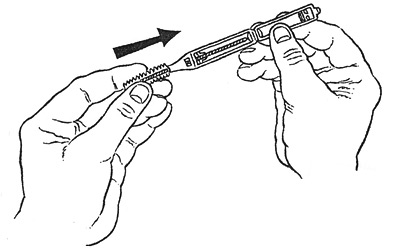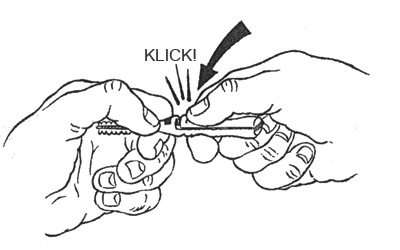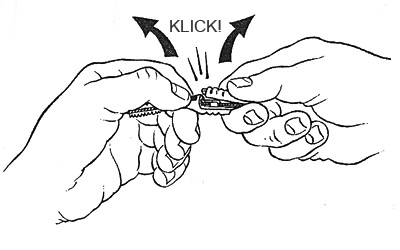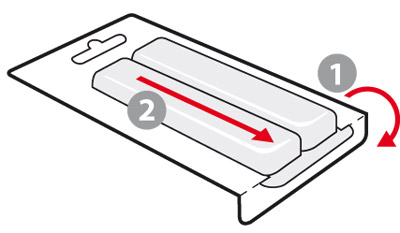User tips
Did you know that:
The most common causes of tooth loss are caries (cavities in the teeth) and gum disease (periodontitis). The symptoms of these diseases can be so minor that serious damage can occur before they are even detected.
These diseases are most common between the teeth, where your ordinary toothbrush struggles to reach.
Inflammation of the gums (gingivitis) is caused by bacteria which can be treated through good oral hygiene. If gingivitis is left untreated, there is a risk that it will spread deeper and the teeth will begin to loosen.
Your regular toothbrush removes bacterial coatings (plaque) from both the front and the back of the teeth. An interdental toothbrush can be used to remove plaque from between the teeth, or from around a bridge or dental implants.
choose the right brush size
The interdental brushes are available in eight sizes.
The specified size is the twisted stem of the brushhead without bristles.
- 0,4 mm / ISO 0
- 0,5 mm / ISO 2
- 0,6 mm / ISO 3
- 0,7 mm / ISO 4
- 0,8 mm / ISO 5
- 0,9 mm / ISO 5-6
- 1,2 mm / ISO 6-7
- 1,5 mm / ISO 8
The brush needs to reach in between the teeth with little resistance and without the plastic-coated metal wire scraping against the surface of the tooth. Do not choose a brush that is too large. This will cause the steel wire in the brush to bend easily and after a while the nylon strands may come loose. The steel wire can also damage the surface of the tooth. If this happens, try using a smaller size.
How do interdental brushes work?
Feel free to hold the brush perpendicular to the row of teeth so that it can be easily inserted in and out of the space. Brush with a light pressure against the gums back and forth approx. 10 times. The brushes can be used with or without handles according to your own taste.
When are interdental brushes used?
The best time to use an interdental brush is before ordinary toothbrushing. This is so as not to remove the fluoride-containing toothpaste foam which gets between the teeth during ordinary toothbrushing.
Do not use toothpaste on your interdental toothbrush as this can cause unnecessary abrasion on the surface of the tooth.
How to store interdental brushes
Do not store used brushes together with unused brushes. Rinse the brush with water after use and store in a cool, dry place until the next time.
The accompanying cap can be used either as an extender or to protect the brush during storage.
Durability of the brush
HOW LONG CAN I USE AN INTERDENTAL BRUSH FOR BEFORE REPLACING IT?
Used correctly, an interdental toothbrush can be used repeatedly before it needs to be replaced. Watch our for deformations and wear. Replace the brush at first sight of damage.
Problems when brushing
If the interdental brush bends when inserted between the teeth, try using a smaller size instead.
There may be tartar between the teeth which prevents passage of the brush. Contact your dentist if this is the case.
If the inner gum line is higher then the brush will not have free passage. Bend the brush slightly to facilitate passage.
For increased control when inserting the brush, hold it as close to the end of the brush head as possible.
If the brush gets stuck when you are pulling it out, move it towards the gum where there is more space and use a slight rotating movement to remove it from your teeth.
Uneven fillings or the edges of dental crowns may cause the bristles to stick between the teeth. Contact your dentist for a solution.
Using a handle
1. Insert the brush into the handle.

2. Press the handle together with your thumb and index finger.

3. Open the handle by bending as shown in the figure.

Opening the packaging

1. Fold away the lower part of the packaging as pictured.
2. The plastic casing containing the brushes can then be pulled out and used separately as a storage case for the brushes as it can be opened and closed again.
USER TIPS
Did you know that:
The most common causes of tooth loss are caries (cavities in the teeth) and gum disease (periodontitis). The symptoms of these diseases can be so minor that serious damage can occur before they are even detected.
These diseases are most common between the teeth, where your ordinary toothbrush struggles to reach.
Inflammation of the gums (gingivitis) is caused by bacteria which can be treated through good oral hygiene. If gingivitis is left untreated, there is a risk that it will spread deeper and the teeth will begin to loosen.
Your regular toothbrush removes bacterial coatings (plaque) from both the front and the back of the teeth. An interdental toothbrush can be used to remove plaque from between the teeth, or from around a bridge or dental implants.
choose the right brush size
The interdental brushes are available in eight sizes.
The specified size is the twisted stem of the brushhead without bristles.
- 0,4 mm / ISO 0
- 0,5 mm / ISO 2
- 0,6 mm / ISO 3
- 0,7 mm / ISO 4
- 0,8 mm / ISO 5
- 0,9 mm / ISO 5-6
- 1,2 mm / ISO 6-7
- 1,5 mm / ISO 8
The brush needs to reach in between the teeth with little resistance and without the plastic-coated metal wire scraping against the surface of the tooth. Do not choose a brush that is too large. This will cause the steel wire in the brush to bend easily and after a while the nylon strands may come loose. The steel wire can also damage the surface of the tooth. If this happens, try using a smaller size.
How do interdental brushes work?
Feel free to hold the brush perpendicular to the row of teeth so that it can be easily inserted in and out of the space. Brush with a light pressure against the gums back and forth approx. 10 times. The brushes can be used with or without handles according to your own taste.
When are interdental brushes used?
The best time to use an interdental brush is before ordinary toothbrushing. This is so as not to remove the fluoride-containing toothpaste foam which gets between the teeth during ordinary toothbrushing.
Do not use toothpaste on your interdental toothbrush as this can cause unnecessary abrasion on the surface of the tooth.
How to store interdental brushes
Do not store used brushes together with unused brushes. Rinse the brush with water after use and store in a cool, dry place until the next time.
The accompanying cap can be used either as an extender or to protect the brush during storage.
Durability of the brush
HOW LONG CAN I USE AN INTERDENTAL BRUSH FOR BEFORE REPLACING IT?
Used correctly, an interdental toothbrush can be used repeatedly before it needs to be replaced. Watch our for deformations and wear. Replace the brush at first sight of damage.
Problems when brushing
If the interdental brush bends when inserted between the teeth, try using a smaller size instead.
There may be tartar between the teeth which prevents passage of the brush. Contact your dentist if this is the case.
If the inner gum line is higher then the brush will not have free passage. Bend the brush slightly to facilitate passage.
For increased control when inserting the brush, hold it as close to the end of the brush head as possible.
If the brush gets stuck when you are pulling it out, move it towards the gum where there is more space and use a slight rotating movement to remove it from your teeth.
Uneven fillings or the edges of dental crowns may cause the bristles to stick between the teeth. Contact your dentist for a solution.
Using a handle
1. Insert the brush into the handle.

2. Press the handle together with your thumb and index finger.

3. Open the handle by bending as shown in the figure.

Opening the packaging

1. Fold away the lower part of the packaging as pictured.
2. The plastic casing containing the brushes can then be pulled out and used separately as a storage case for the brushes as it can be opened and closed again.
